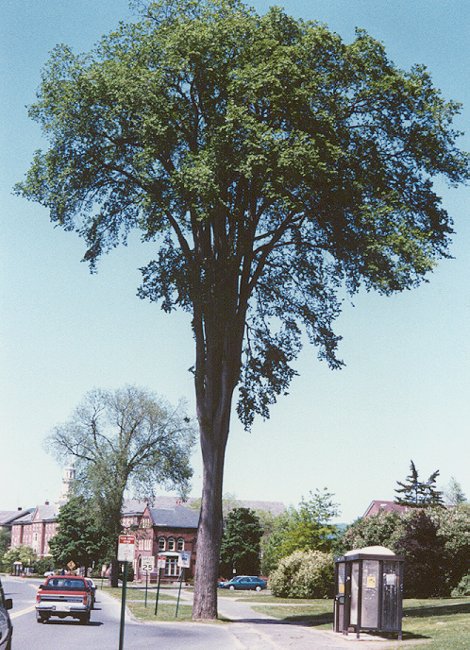
"A shapely American elm at the University of Massachusetts, Amherst, MA "
Source: http://www.elmpost.org/, accessed 27 August, 2010.
When I was a lad American elms were large shade trees that lined many a street in my home town of Wilmette, Illinois. In fact, most towns of any size in America still have an Elm Street. But during the latter half of the 20th Century the species was almost made extinct by a fungal blight called Dutch Elm Disease, that was carried by a beetle that bored into their bark.
Here in New England our autumns have always been spectacular because our forests are so diverse. It is said that New Hampshire has more different species of deciduous trees than anyplace else on Earth, with the possible exception of some parts of Siberia. Our autumn colors are legendary. But I remember the view to the east from the fourth floor of James Hall at Amherst College in 1961, and I truly miss the Elms. We no longer have the glowing yellow highlights that they lent to the autumn forest's flames.
Today there is hope for a regeneration of the American Elm. Several non-profit organizations have been working to produce clones of the few surviving elm trees, those that had some natural resistance to Dutch Elm Disease.
The Campton Conservation Commission teamed up with the local garden club and the town's historical society to buy one of those cloned trees, and has planted it across the road from our home, in The Pattee Meadow. Our home was once the farm house of the Pattee family, and the field across the road was where the local regiment of New Hampshire Volunteers held "musterings" during the Civil War. So that field, which the town bought as conservation land just two years ago, after Eddie Pattee, the last of the line to live here in Campton, passed away, was as good a place to plant the elm as any. Especially so, as this tree came from the Elm Research Institute (ERI) of Keene, NH, sponsors of the American Liberty Elm program.
The ceremonial planting occurred two weeks ago tomorrow, on 14 August, the 235th anniversary of the day that the evacuating British Army cut down the Elm tree in Boston which had been the meeting place of the Sons of Liberty, and which has gone down in history (and in a Disney dramatization) as "The Liberty Tree."
 |
| The first gold leaf. |



Thanks for the pics. They're great to see.
ReplyDeleteIt's 2014 now... is this tree still alive? We have been living in the same house for 40-plus years and have seen "volunteer" trees which I inoculated with Elm Research Institute's elm fungicide, equipment, and methods, plus "Liberty Elm" seedlings shipped to us by ERI and lovingly planted, grow to maturity, prosper, and then die of Dutch elm disease as soon as they get to be 15 or 20 years old. We have two ERI trees left, and they are fine, but I will not be surprised if they "flag" and die before I do. It takes a few weeks usually toward the end of summer to go from healthy to obviously dying. The tipoff is curled yellow leaves on the ground when others are all still green. The next spring will show about 1/4 new green which will be gone by June, and it's over. I love elms and will continue to watch for new hybrids to try, but I'm pretty sure that ERI is at best too optimistic or at worst, calculating in pitching their products. Our experience shows that most elms thrive (store-bought or volunteer) until their bark becomes "interesting" to elm bark beetles, when most become hosts, are infected, and die soon after.
ReplyDeleteDear Anonymous,
DeleteYes, this tree is healthy still. We are holding out hope that it will thrive to full maturity, and die of old age, after all people now living have preceded it to their destinies. -Duncan